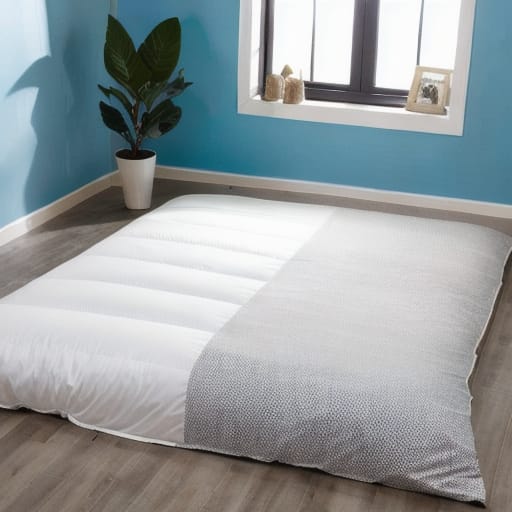You just invested in a luxurious down comforter for your bed, expecting years of blissfully warm and comfortable sleep. But shortly after putting it into service, you notice it’s not quite as thick and fluffy as it used to be. What gives?
Getting flat is a common issue for down comforters. But with some knowledge of fill power, fill weight, manufacturing, and care, you can choose the right down comforter for lasting loft and fluff. This beginner’s guide will explain exactly why down comforters lose their puffiness over time, as well as tips to prevent it.
What Is a Down Comforter?
Before diving into why down comforters go flat, let’s review what exactly a down comforter is.
A down comforter is a type of quilt or duvet filled with down, which refers to the layer of fine, fluffy feathers found closest to a bird’s skin, underneath the thicker exterior feathers. Goose down and duck down are most commonly used.
The tiny down clusters are what give down comforters their signature softness and lightweight warmth. They trap air between feathers to act as excellent insulation.
Down used to fill comforters is sterilized and processed to remove sharp quills or feather shafts. This leaves only the soft, fluffy down that makes comforters feel like a dream.
Factors That Impact Down Comforters Going Flat
Many factors impact how well a down comforter retains its loft and plumpness over years of use. The major ones are:
- Fill power
- Fill weight
- Shell fabric
- Stitching method
- Care
Understanding how these factors affect your down comforter’s longevity can help you find one that stays poufy for longer.
Fill Power and Fill Weight
Fill power measures the fluffiness and thermal insulation capacity of down fill. It ranges from about 300 to 900. The higher the fill power, the better the down clusters can trap air and provide warmth for their weight.
Fill weight refers to the total weight of down inside the comforter. It’s measured in ounces.
You might think higher fill power automatically means more insulation and puffiness. But on its own, fill power doesn’t give the full picture. It would help if you considered it along with fill weight.
Here’s an example:
- Comforter A with 700 fill power and 12 oz fill weight
- Comforter B with 600 fill power and 16 oz fill weight
Comforter B will likely feel fuller and warmer even though its fill power is lower. That’s because total down weight plays a key role too.
Over time, down comforters lose fill as feathers poke through the shell. Higher fill weight means there’s more down to start with, so it takes longer to go flat.
Shell Fabric
The outer shell of the comforter plays a big role in longevity too. Tighter weave patterns like percale do better at keeping feathers contained. Sateen weaves with more space between threads tend to let fill escape faster.
Some stitching patterns also handle wear and tear better:
- Baffle box construction has fabric walls that prevent fill from shifting. This helps retain loft.
- Sewn-through comforters allow fill to move around freely within compartments. These flatten more rapidly.
- Diamond quilt comforters have stitches crossing at diagonal angles for durability.
- Gusseted sides add extra fabric around the edges so comforters fit better inside duvet covers.
Care and Maintenance
Proper care also plays a key role in helping down comforters retain their loft. With the right washing guidance, you can keep fill power intact longer before needing to re-cover or replace your comforter.
- Using a duvet cover prevents body oils and dirt from degrading the shell fabric and fill.
- Washing too frequently, or with harsh detergents, can damage down clusters.
- Tumble drying can clump and mat feathers. Air drying is best.
Some comforters come with *warranties against manufacturer defects or loss of warmth. But improper care often voids coverage, so follow guidelines.

When To Re-Cover or Replace a Flat Comforter
Over years of use, even high quality down comforters get lumpy, flat spots. Excess handling and compression create worn areas as feathers shift and escape.
Signs it’s time to consider re-covering or replacing your down comforter:
- It feels thinner and less warm, lacking insulating properties.
- The fluffy loft is gone, leaving a sad pancake blanket.
- Lumpy sections have little fill left inside.
If the shell fabric remains intact, you may be able to add new down fill to restore fluffiness. This is called re-covering or renovating the comforter.
Costs range from $100-300 depending on size. It requires skilled work to distribute fill and prevent leaks evenly. So assess costs compared to purchasing new when deciding.
Sizing Down Comforters Properly
Getting the right comforter size allows for that puffed, billowing look when made up on the bed. Too small, and it pulls tightly. Too large, and fill doesn’t fill out the shell fully.
Mattress sizes follow standard dimensions in the US:
But comforter sizes can vary between manufacturers. Some use the names but don’t follow set dimensions.
See the problem? Your “queen” comforter might not fit a standard 60 x 80 inch queen bed.
Here are some common comforter sizes:
| Size | Dimensions |
|---|---|
| Twin | 66″ x 86″ |
| Full/Queen | 86″ x 86″ |
| King | 102″ x 90″ |
California King comforters run around 108” x 102”.
Pillowtops add padding for extra plushness while Olympic Queen and California King sizes suit extra thick mattresses.
Getting a comforter about 2 inches wider all around helps achieve that puffy “hotel bed” look once the duvet and pillows are set.

Conclusion: Do Your Down Comforter Homework
While losing loft over time is inevitable for down comforters, you can maximize puffiness by selecting the right fill, fabric, and care.
Follow this beginner’s advice when shopping:
- Assess fill power along with fill weight, not alone
- Choose tighter shell weaves (like percale) and baffle box stitching
- Care properly for your down comforter type
- Buy the right size for your mattress with some overhang
With knowledge on your side, you can enjoy a fluffy, dreamy down comforter for years of blissful sleep. No sad pancake blankets allowed!
Frequently Asked Questions
What is the average lifetime of a down comforter?
With proper care, a quality down comforter will last around 5-10 years before needing to be re-covered or replaced. Higher fill power down that lofts better tends to have more durability than lower grades.
How often should you wash a down comforter?
Only wash down comforters 1-2 times per year at most. Frequent washing damages down clusters and decreases loft. Using a duvet cover helps keep your comforter cleaner for longer between washes.
Why does my down comforter have flat, thin spots?
Lumpy, flat spots are a sign your down comforter needs replacing or re-covering. Over time, fill escapes through the shell or shifts around, leaving gaps without insulation. If the shell remains intact, adding new fill can restore even fluffiness.
Is goose or duck down better?
Goose down has higher fill power, meaning greater loft and warmth per ounce. It also lasts longer with proper care. However, duck down is less expensive, also providing good comfort. Test out fill powers with each type to assess quality and value.
How much does it cost to re-cover a down comforter?
Prices range from $100-300 depending on size. Re-covering requires skilled work to evenly distribute fill without leaks. Costs mount on larger sizes like king. Compare to new comforter prices when deciding whether to re-cover or replace an old, flat one.








